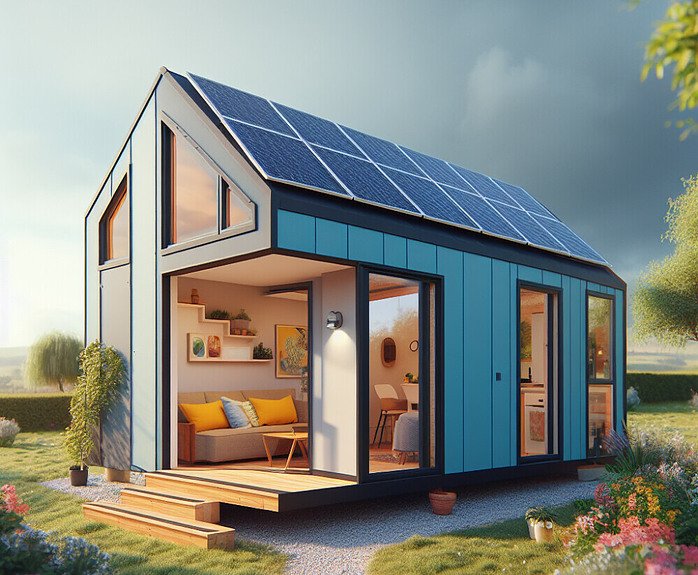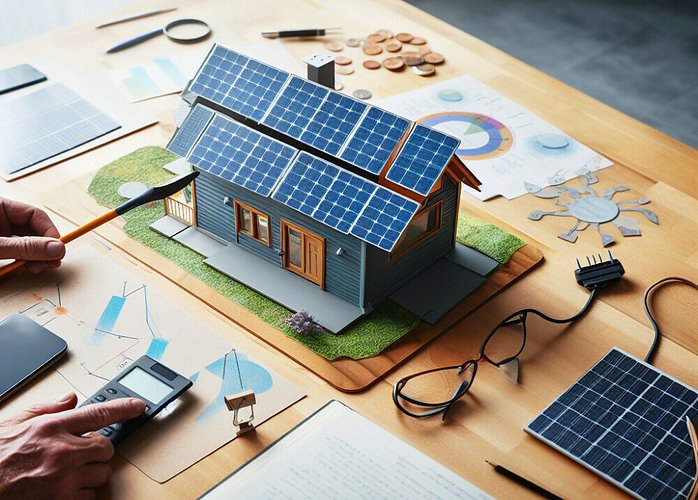In recent years, the popularity of tiny homes has surged as more individuals choose a minimalist lifestyle over traditional housing. This movement towards downsizing not only represents a shift in housing preferences but also reflects a growing awareness of environmental sustainability. Why Choose Solar Panels For Your Tiny Home? This article explores the reasons why tiny homeowners are increasingly turning to solar panels and how these compact dwellings harness the power of the sun efficiently.
Benefits of Solar Panels for Tiny Homes
Tiny homeowners are embracing solar panels to foster self-sufficiency and eco-friendly living. The compact size of tiny homes allows for efficient energy use, making it easier to harness the power of the sun through solar technology. This move towards renewable energy aligns with the values of many tiny homeowners, who seek to minimize their environmental footprint and reduce reliance on traditional energy sources.
Your Tiny Home, Powered Right
Plan with purpose, live with a system that works for you.
Overview of Cost Savings and Environmental Benefits
The decision to integrate solar panels into tiny homes goes beyond environmental consciousness; it also brings substantial cost savings. The initial investment in solar panels is offset by long-term reductions in energy bills, making it a financially savvy choice. Additionally, the environmental benefits are significant, as solar power produces clean, renewable energy, reducing dependence on fossil fuels and lowering carbon emissions.
By embracing solar technology, tiny homeowners are not only cutting down on their energy expenses but also contributing to a greener and more sustainable future. The combination of tiny living and solar power is proving to be a powerful solution for those seeking a more conscious and economically viable lifestyle.
Harnessing the UK Climate: Why Solar Works for Tiny Homes

Tiny homes have gained popularity in the UK for their sustainability and minimalistic living. One key component in making these small dwellings energy-efficient is harnessing the power of the sun through solar panels. Despite common misconceptions about the need for direct sunlight, solar energy proves to be a viable and efficient solution even in the UK’s varying weather conditions.
Misconception about Solar Panels Needing Direct Sunlight
A prevailing misconception is that solar panels require direct sunlight to generate electricity efficiently. While direct sunlight is optimal, modern solar technology has advanced to utilize daylight effectively, even in diffused or indirect sunlight. This makes solar panels a practical choice for tiny homes in the UK, where the weather can be unpredictable.
Explanation of How Solar Panels Use Daylight in the UK
Solar panels function by converting sunlight into electricity through photovoltaic cells. These cells can harness both direct and diffused sunlight, converting it into usable energy for powering homes. In the UK, where overcast skies are common, solar panels are designed to capture diffuse light, ensuring a steady generation of electricity, even on cloudy days.
Design With Confidence
Simplify power, layout, and lifestyle choices in one clear guide.
Examples of Solar Efficiency in Varying Weather Conditions
Contrary to popular belief, solar panels can still generate a significant amount of power on cloudy days. Advanced technology allows solar installations to adapt to varying weather conditions. Research indicates that solar panels can produce electricity even when it’s overcast, with efficiency levels ranging from 10% to 25%, depending on the specific weather conditions. This showcases the resilience and adaptability of solar power systems to the UK’s climate.
1. Clear Sunny Days

Solar panels perform at their peak efficiency on clear, sunny days with abundant sunlight. Efficiency can reach close to 100%, allowing for optimal energy production.
2. Partly Cloudy Conditions
Solar panels’ efficiency on partly cloudy days generally ranges from 70% to 90% of their optimal performance. These figures are approximate and depend on factors like panel design, technology, cloud cover, and panel orientation.
3. Overcast Days
On overcast days, solar panel efficiency typically drops to around 50% to 70% of optimal performance due to reduced direct sunlight. Factors such as cloud cover thickness, panel type, and technology influence this decrease in efficiency.
4. Rainy Days
On rainy days, solar panel efficiency is typically 10% to 30% of optimal performance due to reduced sunlight. Factors like rainfall intensity, panel type, and technology influence this decrease in efficiency. Ongoing advancements aim to improve efficiency during rainy weather.
5. Winter Conditions

Solar panel efficiency in winter can drop by approximately 10-25%, compared to peak efficiency depending on factors like location and weather. Advances in technology and design aim to mitigate these losses, and the impact varies based on specific climate conditions.
The Impact of the UK’s Climate on Solar Power Generation for Tiny Homes
The UK’s climate, characterized by frequent rain and cloudy days, might seem challenging for solar power. However, statistics reveal that the country receives a considerable amount of daylight throughout the year. Tiny homes equipped with solar panels can take advantage of this available daylight to generate a consistent and sustainable power supply.
The adaptability of solar panels to varying weather conditions aligns perfectly with the UK’s climate. Even during winter months or overcast days, solar panels can contribute significantly to the energy needs of tiny homes. This not only reduces reliance on traditional energy sources but also minimizes the environmental impact associated with conventional power generation methods.
Calculating the Benefits: Energy Savings and System Sizing
In the quest for sustainable living, the comparison between average UK household electricity usage and the emerging trend of tiny homes highlights a significant disparity. Tiny homes, characterized by their compact size and minimalistic approach, can yield substantial energy savings. This article explores the potential benefits of adopting tiny homes, focusing on how they can save between 50% to 90% on energy consumption.
Energy Savings in Tiny Homes
Tiny homes present an innovative solution to reducing energy consumption. By embracing a minimalist lifestyle, occupants can significantly cut down on the need for heating, cooling, and overall electricity usage. The average UK household’s electricity consumption is notably higher than that of a tiny home, making the latter an appealing choice for those looking to decrease their environmental impact and utility bills.
On average, tiny homes can achieve energy savings ranging from 50% to an impressive 90%. The smaller footprint and efficient design contribute to lower energy demands, and with conscious choices in appliances and insulation, occupants can further enhance these savings.
Determining Solar Panel Requirements

Harnessing solar energy is a key strategy for powering tiny homes sustainably. The calculation of solar panel requirements involves several factors, including the location, energy needs, and efficiency of the solar panels.
To determine the number of solar panels needed for a tiny home, one must first assess the average daily energy consumption. This includes the power requirements for lighting, appliances, and heating or cooling systems. With this information, one can then factor in the local sunlight conditions and the efficiency of the chosen solar panels.
Bring Your Tiny Vision to Life
Live simpler, smarter, and more confident with a guide designed for you.
Modern Solar Panel Efficiency
The efficiency of solar panels plays a crucial role in maximizing energy production. Traditional solar panels typically have an efficiency range of 15% to 20%, meaning they can convert that percentage of sunlight into electricity. However, advancements in technology have led to the development of higher-efficiency panels, with some exceeding 22%.
The average size of modern solar panels varies, but it is commonly around 17.6 square feet (1.63 square meters) for a panel with an efficiency of 20%. Smaller panels may be preferred for tiny homes with limited roof space, while higher efficiency panels can compensate for the reduced surface area.
Investing in Your Tiny Home’s Future: Costs and Returns of Solar Energy
As the world moves towards sustainable living, investing in solar energy for your tiny home has become an increasingly attractive option. Let’s take a look at the evolving landscape of upfront solar panel costs, and the potential returns on investment over a 25-year lifespan, and provide a breakdown of real-life scenarios showcasing the ROI based on usage and system size. This exploration aims to empower you to make informed decisions about the financial aspect of adopting solar power for your tiny home.
Decreasing Upfront Costs
One of the most significant developments in the solar energy sector is the recent decrease in upfront solar panel costs. Technological advancements, increased production, and government incentives have contributed to a more accessible entry point for homeowners looking to invest in solar energy. The decreasing costs make it increasingly feasible for tiny home enthusiasts to embrace sustainable energy solutions without breaking the bank.
Potential Return on Investment (ROI) Over 25 Years
Investing in solar panels for your tiny home is not just a commitment to sustainability; it’s a long-term financial strategy. Assessing the potential return on investment over a 25-year lifespan is crucial in understanding the economic benefits. Factors such as reduced electricity bills, potential incentives, and increased property value contribute to the overall ROI.
Real-life ROI Scenarios
To provide a practical perspective, let’s explore real-life scenarios showcasing ROI based on usage and system size for a tiny home. By considering factors such as location, energy needs, and local incentives, we can illustrate how investing in solar energy pays off over time. Whether you’re a minimalist with basic energy needs or someone who wants to power a fully-equipped tiny home, these scenarios will help you gauge the financial viability of adopting solar power.
Real-life ROI Scenario 1: Basic Energy Needs
Imagine a minimalist individual living in a tiny home with basic energy needs. This person requires energy for lighting, a small refrigerator, and occasional device charging. A modest solar energy system, costing around £8,000 upfront, powers the tiny home.
– Upfront Solar System Cost: £8,000
– Average Monthly Savings on Electricity Bills: £30
– Annual Savings: £360
In this scenario, the system pays for itself in approximately 22 years, factoring in the decreasing upfront costs and potential future electricity rate increases. Over the 25-year lifespan of the solar panels, the homeowner could potentially save around £9,000, showcasing a modest but meaningful return on investment.
Real-life ROI Scenario 2: Fully-equipped Tiny Home
Now, consider a tiny home equipped with energy-intensive appliances such as a washer, dryer, and air conditioning. The solar system for this scenario costs £15,000 upfront, providing enough power to sustain the increased energy demands.
– Upfront Solar System Cost: £15,000
– Average Monthly Savings on Electricity Bills: £75
– Annual Savings: £900
Despite the higher upfront cost, the solar system pays for itself in approximately 17 years. Over the 25-year lifespan, the homeowner could save around £22,500 on electricity bills, demonstrating a more substantial return on investment due to the higher energy demands being offset by solar power.
Real-life ROI Scenario 3: Location-based Incentives
Consider a tiny home located in an area that offers significant solar energy incentives. The upfront cost for the solar system is £10,000, but with local incentives and tax credits, the effective cost is reduced to £6,000.
– Effective Upfront Solar System Cost (after incentives): £6,000
– Average Monthly Savings on Electricity Bills: £50
– Annual Savings: £600
In this scenario, the solar system pays for itself in approximately 10 years, showcasing the impact of incentives on ROI. Over the 25-year lifespan, the homeowner could save around £15,000 on electricity bills, demonstrating how regional support can significantly enhance the return on investment.
These real-life scenarios highlight how the combination of energy needs, system size, upfront costs, and location-specific factors can influence the return on investment for solar energy in a tiny home. Individuals need to consider their unique circumstances and conduct a thorough analysis to determine the most financially viable solar solution for their tiny homes.
Conclusion
In essence, the rise of solar-powered tiny homes signifies a shift towards sustainable living. Overcoming weather misconceptions and decreasing costs, these homes offer both eco-consciousness and financial viability. The blend of tiny living and solar power is an environmentally friendly and economically smart choice, showcasing a conscious way of living.







